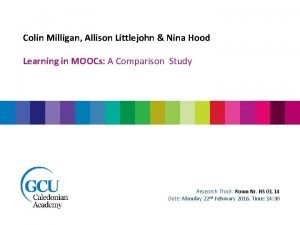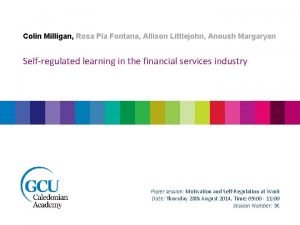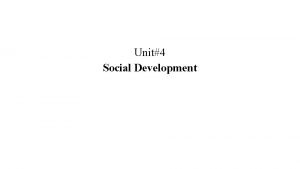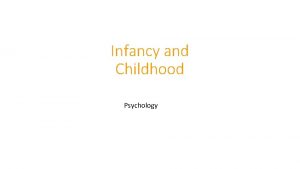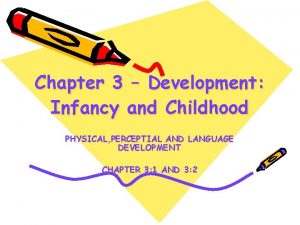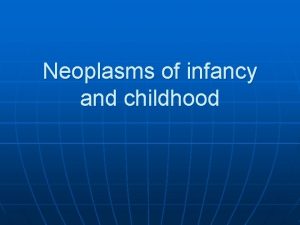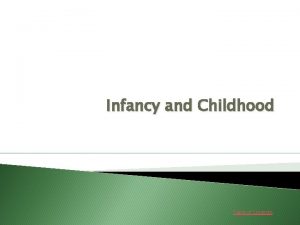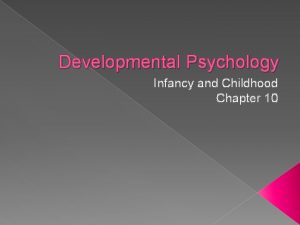Life Changes Marco Rodriguez and Eliza Milligan Infancy















- Slides: 15

Life Changes Marco Rodriguez and Eliza Milligan

Infancy (birth- 1 yr) Emotional Development: - Newborns show excitement Physical Development: - 22 inches in length - their emotional behavior in later stages of life - By 4 to 6 months of age more Infants react to discomfort (pain, hunger, cold) by crying - At birth they are unable to The weight triples in the first speak but in the first 6 year of life months of age they Most infants are born with no understand basic words teeth but in the first year will - - about 6 -8 lbs and measure 18 - Events that happen in their first year of life have an influence on Newborn babies usually weigh Mental Development: have 10 -12 baby teeth - By 4 months of age, infants can recognize their parents emotions can be seen such as or close ones and stare at anger, fear, disgust, etc others

Social Development: - By 4 months of age infants recognize their parents - By 6 months of age the infants watch activities of others - By the 12 month of age infants may still be shy with strangers

Early Childhood (1 -6 yr) Physical Development: - - - From 1 -6 years of age physical growth is slower than during infancy The legs and lower body develop quicker than the head and arms in this stage Between ages 2 and 4 most children learn bladder and bowel control Mental Development: - At age 1 they know several words but by age 6, they have a Emotional Development: - At the age of 1 & 2 children learn to develop self vocabulary of 1500 -2000 words - 2 yr olds have a very short attention spand but are awareness - Children feel impatient and frustrated as they try to do interested into many activities - By age 6 they know how to speak and make decisions new things - By ages 4 -6 children will be able to control their emotions

Social Development: - They are strongly attached to parents and are scared of any separation - They start to play with other children - They need to learn to be responsible and respect others at this stage

Late Childhood (6 -12 yr) Physical Development: - - - The weight gain average is about 5 -7 lbs per year and the height average is 2 -3 in per year They start losing teeth and getting permanent ones The eyes are well developed and eyesight is the best during this stage of life Mental Development: - More speech, reading, and - As they start school they writing skills are learned are often scared and Memory becomes more uncertain about school complex - Emotional Development: - Gradually fears are They begin to understand replaced with the ability loyalty, honesty, and morals to cope - Emotions are brought under control and dealt with more professionally

Social Development: - 7 yr olds tend to like activities they can do by themselves - Ages 8 -10 tend to be more social in groups - Needs of the children in this age group are basically the same as the infants

Adolescence (12 -20) Physical Development: - - - A sudden growth spurt can cause increases in weight and height Muscle coordination does not advance as quickly This growth spurt appears ages 11 -13 in girls and 13 -15 in boys Mental Development: Increases knowledge and sharpening skills already learned Adolescents learn to make decisions and accept responsibility of their actions At times this causes conflict and are told to “grow up”, being reminded that they are still children Emotional Development: - They often worry about their appearance and relationships with others - They respond more to peer group influences - They gain more control of their emotions and are more mature in an emotional state

Social Development: - Spending less time with family and more time with peers and friends - At this age group having friends boosts your confidence - In the age group they experience worse things like suicide and drugs

Early Adulthood (20 -40) Physical Development: - - Development is basically complete Muscles are developed and strong Mental Development: - Development usually This is the time where the healthiest babies are produced - - Young adults experience continues through this stage many emotional distresses Many young adults pursue related to career, marriage, education to help with their and family chosen career - Emotional Development: - If they are emotionally They often deal with making stable, they are able to cope career choices, establishing a with their worries lifestyle, and starting a family - They find satisfaction in their achievements and learn to accept criticism

Social Development: - Frequently involves moving away from your peer groups - Young adults tend to bond with others based on similar interests, regardless of age - The young adult often become involved with a mate and form a family

Middle Adulthood (40 -65) Physical Development: Mental Development: - The hair tends to gray and thin and the skin begins to wrinkle - Muscles tend to decrease - Weight gain occurs Individuals have Emotional Development: - job, fear of aging learned the understanding of life - Stress is created by loss of - Problems with aging parents Have learned to cope with can contribute to emotional many different stresses feelings of depression, Allows them to be more insecurity, or even anger confident in decision making - Emotional status varies in this age group

Social Development: - Social relationships depend on many factors - Family relationships often see a decline as children begin lives of their own - Friendships are usually with people who have same interests and lifestyles

Late Adulthood (65+) Physical Development: - - - Physical development is on decline Much more attention has been directed toward this life stage Bones become more brittle since the bones are weak Mental Development: - - Some show decreased Emotional Development: - Some elderly people cope well mental capacities at much and remain happy and able to earlier ages enjoy life Short- term memory is - Others become lonely, usually the first to decline frustated, withdrawn, and Diseases, such as depressed alzheimer’s disease, can lead to irreversible loss of memory

Social Development: - Retirement can lead to a loss of self- esteem - Many elderly individuals engage in new activities - Less contact with coworkers and less friends can usually occur.
 Infancy physical changes
Infancy physical changes Unto us spike milligan
Unto us spike milligan Nina hood
Nina hood Ex parte milligan apush
Ex parte milligan apush Spike timing dependent plasticity
Spike timing dependent plasticity Colin milligan builders
Colin milligan builders Ruth milligan
Ruth milligan Pia fontana
Pia fontana Changes in latitudes, changes in attitudes meaning
Changes in latitudes, changes in attitudes meaning Example of chemical and physical change
Example of chemical and physical change Social development in infancy
Social development in infancy Module 47 infancy and childhood cognitive development
Module 47 infancy and childhood cognitive development Infancy and childhood psychology
Infancy and childhood psychology 6 life stages
6 life stages Internally programmed growth of a child
Internally programmed growth of a child Chapter 10 infancy and childhood
Chapter 10 infancy and childhood


